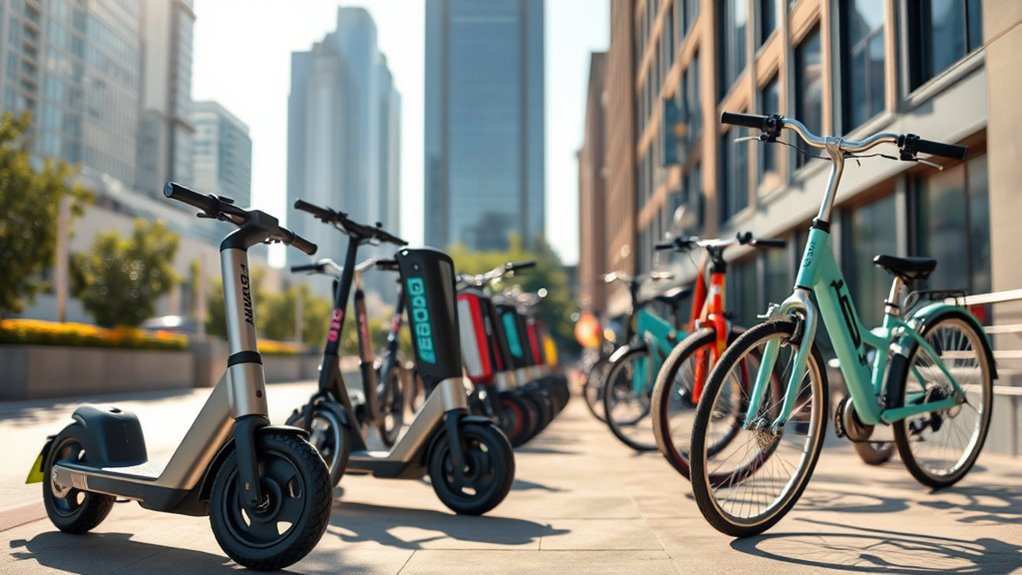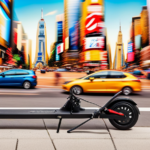In the future of micro-mobility, e-scooters and e-bikes will play different roles based on how cities expand their infrastructure and promote sustainability. E-scooters will remain ideal for short urban trips and last-mile connections, while e-bikes will support longer journeys and utility use among diverse users. Technological advances, better safety features, and smart integrations will boost their adoption. Stay tuned to explore how innovations and regulations will shape this evolving landscape.
Key Takeaways
- E-bikes are expected to dominate longer utility trips, while e-scooters remain preferred for short urban, last-mile travel.
- Innovations in battery technology and smart features will enhance e-bike range and safety, boosting future adoption.
- E-scooters will focus on automation and shared mobility, improving efficiency and user experience in dense cities.
- Infrastructure development and regulatory frameworks will shape the growth and safety standards for both vehicle types.
- Sustainability efforts, such as recycling and eco-friendly materials, will be central to the future competitiveness of e-mobility options.
Growth Trends and Market Dynamics of E-Scooters and E-Bikes

The growth of e-scooters and e-bikes reflects shifting urban mobility preferences and technological advancements. The electric market is booming, with the global e-scooter market expected to hit nearly $42 billion by 2030, fueled by urban adoption. E-bikes, seen as the foundational micromobility solution, started gaining traction around 2015 and saw innovations around 2025–2026, making them ideal for longer trips and replacing cars. E-scooters gained popularity for their affordability and convenience for short urban journeys, though safety and regulatory issues have slowed growth. Market dynamics now show consolidation, with manufacturers focusing on supply chain resilience, recycling, and expanding B2B mobility solutions. Overall, the electric market continues to evolve, shaping the future landscape of micro-mobility. The increasing availability of vetted home theatre projectors also influences urban commuting habits by enabling remote work and entertainment options. Additionally, advancements in electric vehicle technology are contributing to the broader adoption of sustainable transportation methods, which is integral to future urban planning and environmental goals. Moreover, the integration of regulatory frameworks can further accelerate the adoption and safety standards for these emerging mobility solutions. Furthermore, innovations in renewable energy solutions can help power these vehicles more sustainably, reducing their environmental impact.
User Demographics and Trip Preferences for Micro-Mobility Modes

Understanding who uses micro-mobility options and how they prefer to travel reveals important insights into market trends. Demographics show that younger users, mainly men under 49, dominate the scene, with many under 25 or 30. E-bikes are popular for longer trips, commutes, and utility purposes, especially among young families and urban dwellers seeking sustainable transport. Shared e-scooters, on the other hand, are mainly used for leisure, quick city trips, and last-mile connections, with ownership remaining low. The elderly show minimal adoption of shared micromobility, while bike ownership and cargo bikes appeal more to young families. Trip preferences vary: e-scooters excel for short, city-based travel, whereas e-bikes are preferred for longer, utility trips. Additionally, high-contrast visuals and clear displays can enhance user experience and safety in these modes, especially as innovative design continues to evolve to meet diverse user needs. Incorporating aesthetic wall organization principles can also improve the overall user environment in shared mobility hubs and charging stations, making them more inviting and functional. Moreover, understanding user behavior and preferences through personality tests can further optimize service offerings and user engagement strategies. Recognizing user-centered design principles can help developers create more accessible and intuitive solutions for all age groups, including the elderly.
Infrastructure Development and Safety Enhancements
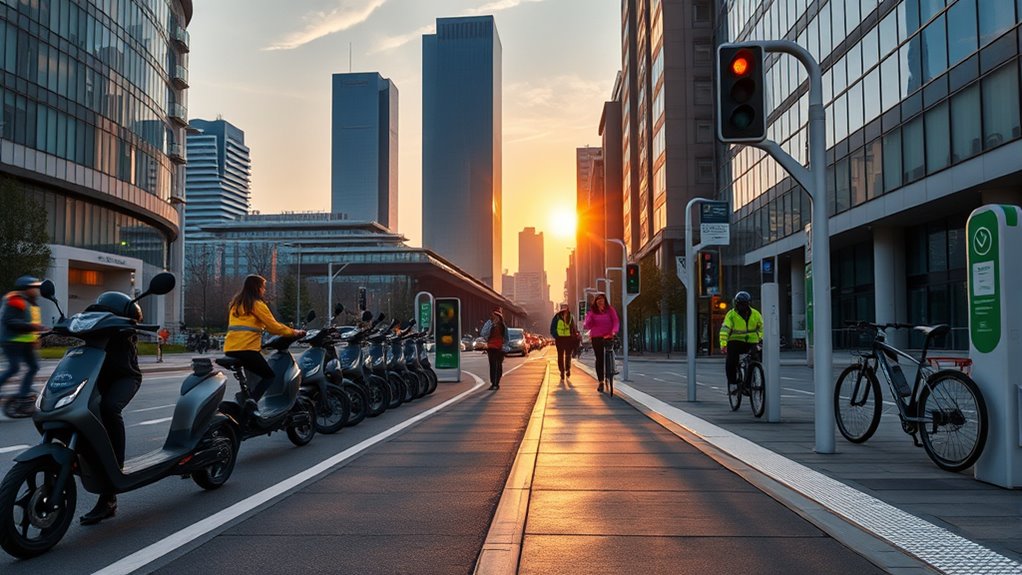
Investing in dedicated, protected bike lanes that run along entire travel routes plays a crucial role in enhancing safety and encouraging more people to adopt micro-mobility modes. Protected lanes separate e-scooters and e-bikes from car traffic, reducing accidents and improving overall safety. Urban upgrades like bright lane markings and organized charging hubs further create a safer environment and help integrate micro-mobility into city infrastructure. Implementing geofencing technology enforces speed limits and restricts parking in pedestrian zones, decreasing sidewalk clutter and accidents. Data-driven safety improvements identify high-risk areas, allowing targeted investments that lower injury rates. Additionally, the integration of digital platforms facilitates real-time monitoring and management of micro-mobility services, further boosting safety and efficiency. Incorporating state-specific safety regulations and tax implications can ensure compliance and optimize cost management for operators. Moreover, adopting safety standards across all micro-mobility vehicles enhances rider protection and reduces incident severity. Utilizing public engagement strategies helps educate users about safety practices and responsible riding behaviors. Recognizing that nutritional value of micro-mobility options can influence user health choices, promoting healthier lifestyles contributes to broader urban wellness. By prioritizing infrastructure development and safety enhancements, you make micro-mobility a safer, more attractive option for urban travel.
Innovations in Vehicle Design and Technology

Innovations in vehicle design are making micro-mobility devices more versatile and user-friendly, with features like modular seating and larger cargo areas. Advanced battery tech is extending range and lifespan, while recycling efforts boost sustainability. Smart features such as GPS and anti-theft systems are also enhancing security and user experience. Additionally, understanding store hours can help consumers plan their trips to pick up or test new mobility devices efficiently. Incorporating tuning techniques from automotive modifications can inspire future enhancements in vehicle customization and performance. Recognizing regional legal resources can also aid users in navigating regulations and ensuring compliant usage of micro-mobility options. Improvements in battery technology are contributing to increased range and durability of e‑scooters and e‑bikes, making them more practical for everyday use. Moreover, ongoing research into user safety features is essential to promote wider adoption and confidence in these emerging transportation modes.
Advanced Battery Technologies
Recent advances in battery technologies are transforming the landscape of micro-mobility, making e-scooters and e-bikes more efficient and versatile. With innovations like solid-state batteries and high-energy-density lithium-ion cells, you’ll notice increased range and faster charging times. Modular battery packs allow quick swaps or upgrades, reducing downtime and boosting flexibility. Fast-charging batteries now enable devices to recharge in under 30 minutes, supporting longer rides and quick turnarounds. Researchers are also exploring recycled and eco-friendly battery materials to make vehicles more sustainable. Subconscious power and smart battery management systems (BMS) further enhance safety, extend battery lifespan, and optimize power delivery. These advancements in battery technology guarantee that your micro-mobility experience becomes more reliable, eco-friendly, and convenient than ever before.
Modular Vehicle Configurations
Advancements in battery technology have paved the way for more flexible and adaptable micro-mobility vehicles. Modular vehicle configurations now let you customize bikes and scooters with interchangeable parts like seats, cargo compartments, and weather shields, making them suitable for various urban trips. Innovations such as removable batteries and adaptable frames extend vehicle lifespan and simplify maintenance. Microcar prototypes and smart e-scooters with configurable modules optimize space, safety, and multi-purpose use. These designs support rapid assembly and disassembly, enabling scalable fleet management and personalized options. Imagine riding through bike lanes with vehicles tailored to your needs. Here’s a snapshot of modular configurations:
| Vehicle Type | Key Features | Benefits |
|---|---|---|
| E-bike | Interchangeable parts | Customization & longevity |
| E-scooter | Configurable modules | Safety & versatility |
| Microcar | Compact & adaptable | Space efficiency |
| Cargo Bike | Removable compartments | Utility & convenience |
Regulatory Frameworks and Policy Developments
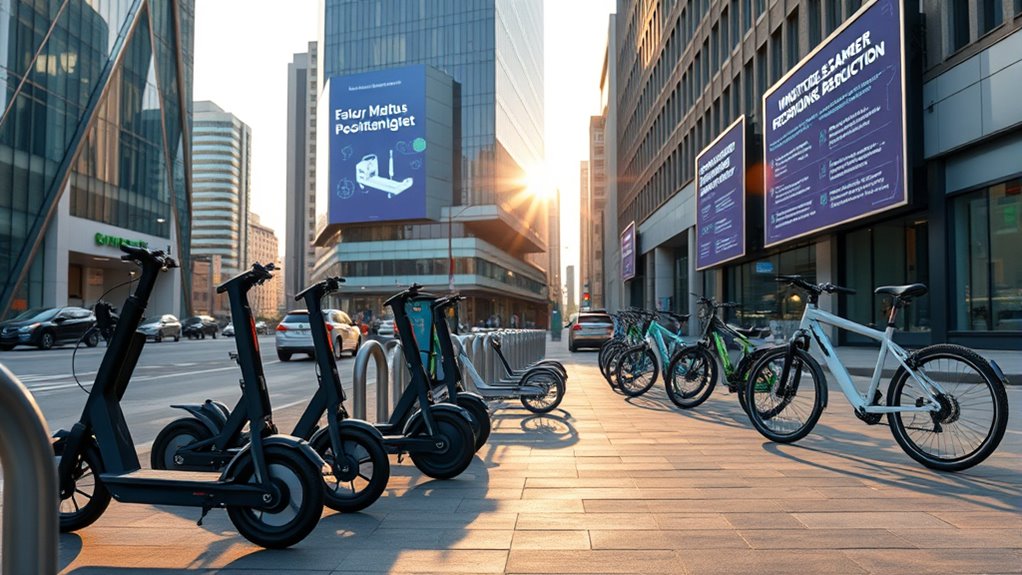
You’ll notice that local regulations for e-scooters and e-bikes differ widely, affecting how these vehicles are used and managed. Safety standards like speed limits and designated zones are becoming common, while policies now often require permits, helmets, and parking solutions. Governments are also exploring incentives, funding, and stricter compliance measures to promote safe and sustainable micromobility.
Local Regulation Variations
Local regulations for e-scooters and e-bikes vary considerably across cities, shaping how these vehicles are used and integrated into urban environments. You’ll notice some places, like California, enforce strict rules such as helmet use and licensing, while others, like Miami, adopt more lenient, pilot-based approaches. Policy innovations include geofencing to control speed and parking zones, but their implementation differs locally. You might find e-scooter restrictions based on age or sidewalk bans, whereas e-bikes often face fewer rules but require licensing and insurance. These differences reflect city priorities like safety, congestion, and mobility.
- Geofencing tech enforces speed limits and designated zones
- Restrictions on sidewalk riding vary by region
- Licensing and insurance requirements differ across jurisdictions
Safety and Compliance Standards
Safety and compliance standards are shaping how cities regulate e-scooters and e-bikes, aiming to minimize risks and protect riders and pedestrians alike. Regulatory frameworks now include safety standards like mandatory helmet use, lighting requirements, and age restrictions, with many regions enforcing strict penalties for violations. Speed limits of 10-15 mph and designated riding zones help reduce accidents and manage traffic flow. Policy developments also focus on licensing, registration, and insurance to ensure accountability. Additionally, geofencing technology is increasingly integrated into these regulations to limit speeds and restrict parking in pedestrian-heavy or restricted areas. These evolving regulatory frameworks work to promote responsible usage, address injury prevention, and improve overall safety for micro-mobility users.
Policy Incentives and Funding
Policy incentives and funding play a crucial role in promoting the adoption and integration of e-bikes and e-scooters into urban transportation systems. Governments and cities are offering various funding initiatives, such as subsidies, grants, and pilot programs, with some regions providing up to 30% subsidies for electric two-wheelers. These policy incentives encourage more people to choose micromobility options. Additionally, funding from federal and local agencies supports infrastructure development, like protected bike lanes and charging stations, making e-mobility more accessible. Regulatory frameworks are also evolving, with licensing, permit systems, and safety standards. The focus is increasingly on integrating micromobility into public transit networks to reduce car dependency and promote urban sustainability.
Regional Adoption Patterns and Cultural Influences
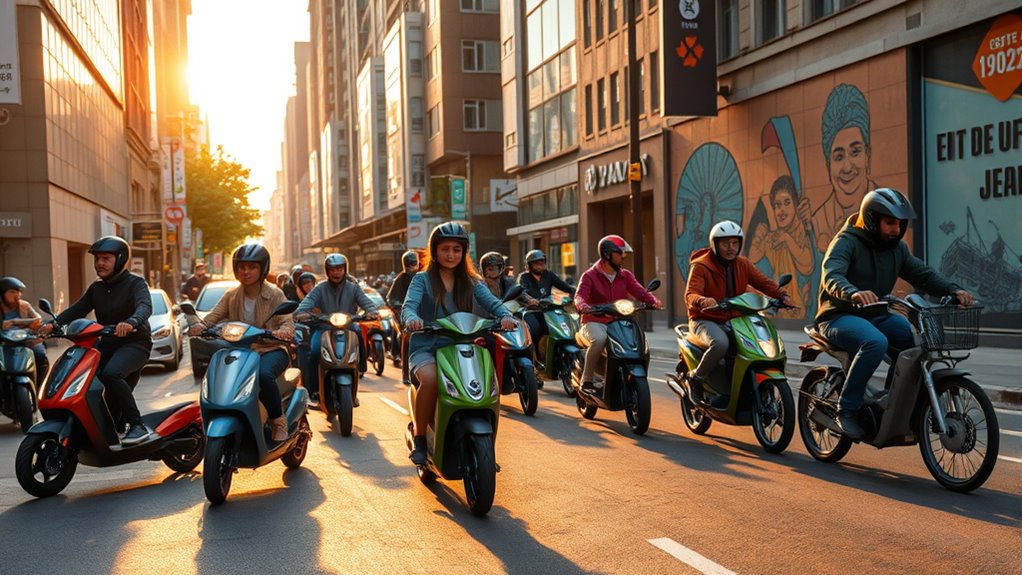
Regional adoption patterns for micro-mobility vary markedly, shaped by cultural attitudes, infrastructure, and economic factors. In countries like the Netherlands and Denmark, a strong cycling culture leads to high e-bike adoption, reinforced by supportive infrastructure and societal norms. Southern European nations, such as Spain and Italy, favor moped use due to dense urban areas and traditional transportation habits. In China and Southeast Asia, bicycles and motorized two- and three-wheelers dominate because they’re affordable and suited to crowded cities. The United States shows regional variation, with cities like San Francisco and New York leading in e-bike infrastructure, influenced by local policies and urban density. Overall, cultural attitudes towards safety and mobility, along with government incentives, profoundly shape regional differences in micro-mobility adoption.
Environmental Impact and Sustainability Goals
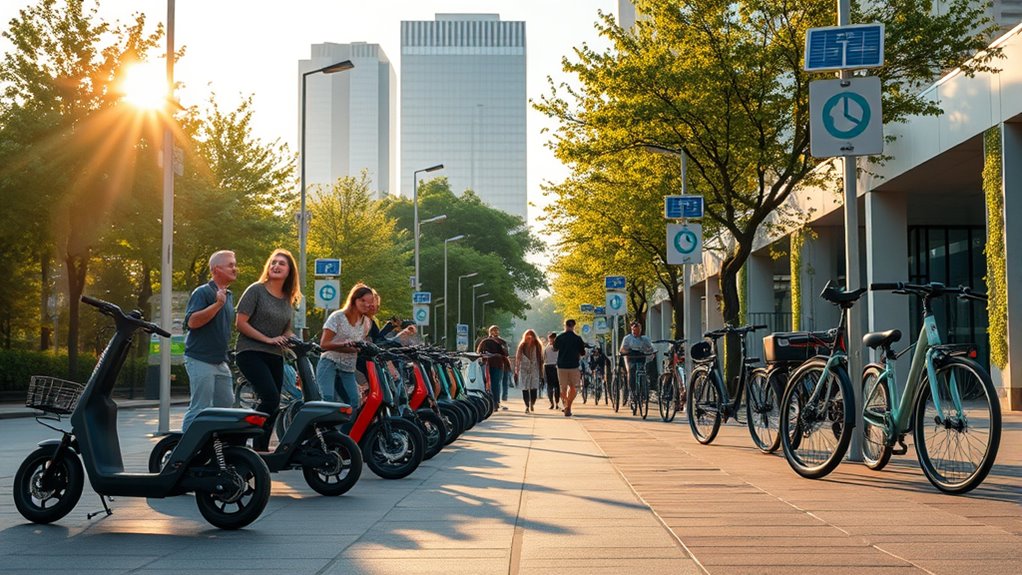
Electric micro-mobility solutions like e-bikes and e-scooters play a crucial role in advancing urban sustainability goals by markedly reducing greenhouse gas emissions compared to traditional vehicles. As electric vehicles, they markedly lower environmental impact, helping cities move toward zero-emission transportation by 2030. Using shared e-bikes and e-scooters decreases reliance on personal cars for short trips, reducing traffic congestion and air pollution in dense urban areas. The industry is also emphasizing circular economy practices, such as recycling batteries and utilizing recycled materials, to improve environmental sustainability. Your adoption of these eco-friendly mobility options supports broader climate initiatives and urban resilience efforts.
Electric micro-mobility reduces emissions and promotes sustainable urban transportation through recycling and shared mobility options.
- Reduced emissions, up to 90% less during operation
- Decreased reliance on personal vehicles for short trips
- Focus on recycling and sustainable materials
Integration With Public Transit and Urban Planning
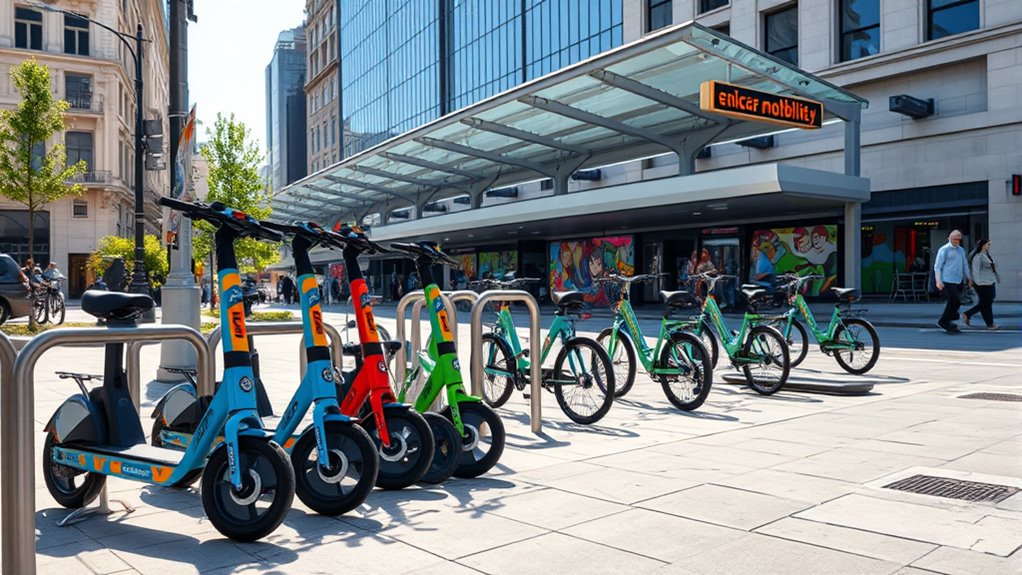
Integrating e-scooters and e-bikes with public transit systems enhances how you move around cities, especially for the first and last miles of your journeys. Cities like Paris and San Francisco use coordinated fare systems and designated docking zones to connect micromobility modes with buses and trains seamlessly. Infrastructure projects such as protected bike lanes and dedicated scooter lanes ensure safe, efficient shift between transit hubs and micromobility devices. Data sharing between transit agencies and micromobility providers enables real-time routing and fleet management, improving your experience. Regulatory policies promote integration through incentives, shared infrastructure, and unified planning efforts, creating cohesive urban transportation networks.
| Aspect | Benefit |
|---|---|
| Fare Coordination | Seamless multimodal trips |
| Docking Zones | Easy access and parking |
| Infrastructure Projects | Safe, protected handover points |
| Data Sharing | Optimized fleet and route management |
| Policy Incentives | Encourages integrated urban mobility solutions |
Challenges and Opportunities for Market Expansion

While e-bikes are poised to lead the micromobility market due to their longer range and enhanced performance, safety concerns and infrastructure gaps remain significant hurdles. Safety concerns, especially related to e-scooter accidents, hinder broader adoption, while inadequate infrastructure limits safe usage. Evolving regulatory frameworks offer opportunities to address these issues through standardized policies on speed limits, parking, and rider safety, paving the way for market growth. To maximize expansion, focus on:
- Developing safer infrastructure tailored for both e-bikes and e-scooters
- Implementing clear, consistent safety regulations across regions
- Leveraging new technologies like autonomous vehicles and recycling batteries to reduce costs and improve scalability
Addressing these challenges and seizing opportunities will be key to accessing the full potential of micromobility markets.
Future Outlook: Innovations and Emerging Trends
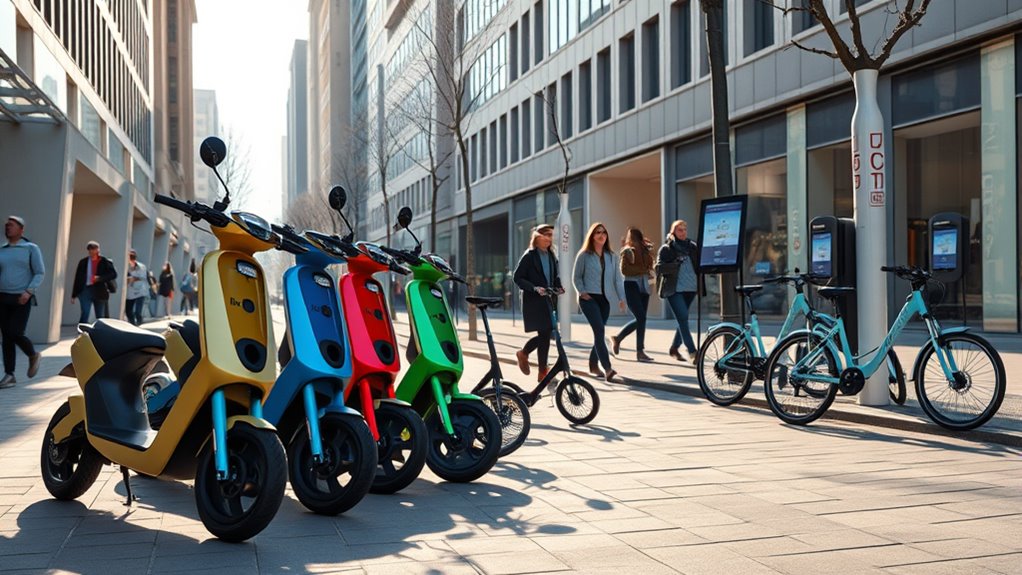
Advancements in battery technology and lightweight materials are revolutionizing the design of e-bikes and e-scooters, markedly boosting their range and durability. These innovations are paving the way for models expected around 2025-2026, offering users longer trips and better reliability. Emerging trends include the development of autonomous micro-mobility vehicles and new microcar concepts, improving last-mile connectivity in dense urban areas. Digitalization drives the integration of smart features like navigation, theft prevention, and digital payments, making rides safer and more convenient. Companies are exploring modular and customizable vehicles to cater to diverse needs, from cargo to different trip types. Additionally, regulatory and safety innovations, such as geofencing and automatic speed regulation, are shaping a smarter, safer future for micro-mobility modes.
Frequently Asked Questions
What Is the Future of Micromobility?
You’re curious about how micromobility will evolve, and it’s clear both e-bikes and e-scooters will play a big role. You’ll see advancements like longer-lasting batteries, smarter safety features, and better urban infrastructure that make these options more practical and safe. As technology and regulations develop, you’ll find micro-vehicles becoming more integrated into daily commutes, offering sustainable, convenient solutions for last-mile travel and reducing urban congestion.
What Are the Micromobility Trends in 2025?
You’ll see exciting micromobility trends in 2025, like longer-lasting e-bike batteries and faster charging, making longer rides possible. E-scooters will get smarter with safety features like geofencing and automatic speed control. Both will shift toward ownership models such as subscriptions and leasing, making them more accessible. Urban areas will invest in protected lanes and pathways, ensuring safer, more efficient rides, and integrating with autonomous systems for last-mile deliveries.
What Are the Trends in Micromobility?
Imagine the micromobility landscape as a bustling city street, alive with innovation. You’ll notice e-bikes becoming the backbone, stretching further with tech upgrades, while e-scooters zoom through short trips, their popularity fueled by shared systems. You’re shifting toward ownership, embracing personalized rides. Emerging tech like microcars and autonomous options are adding new lanes, transforming urban travel into a dynamic, exciting journey tailored to your evolving needs.
How Big Is the Electric Micromobility Market?
You’re wondering about the size of the electric micromobility market. Right now, it’s projected to hit around $42 billion by 2030, showing rapid growth driven by urban demand. E-bikes have gained popularity since 2015, and innovations are boosting the industry. As shared systems expand globally, especially in Europe, North America, and Asia, the market’s size continues to grow, reflecting a strong shift toward sustainable, connected urban mobility solutions.
Conclusion
As you navigate the future of micro-mobility, remember that just like the steam engine revolutionized transport in the Industrial Revolution, e-scooters and e-bikes are reshaping urban travel. Embrace innovations, adapt to evolving policies, and prioritize sustainability. By staying ahead of these trends, you’ll help craft smarter, greener cities—no DeLorean needed—where efficient micro-mobility becomes the norm, not the exception. The journey to a better urban future is already underway; all that’s missing is your ride.
